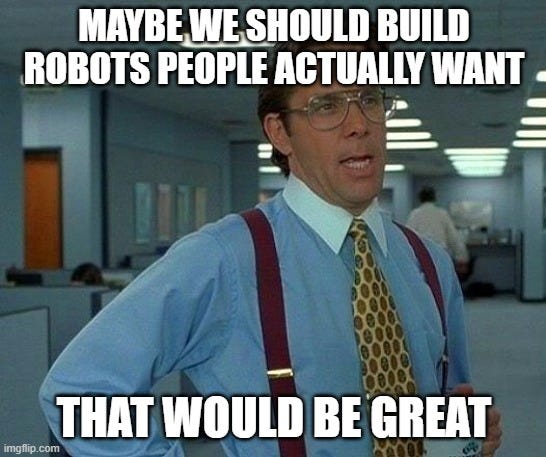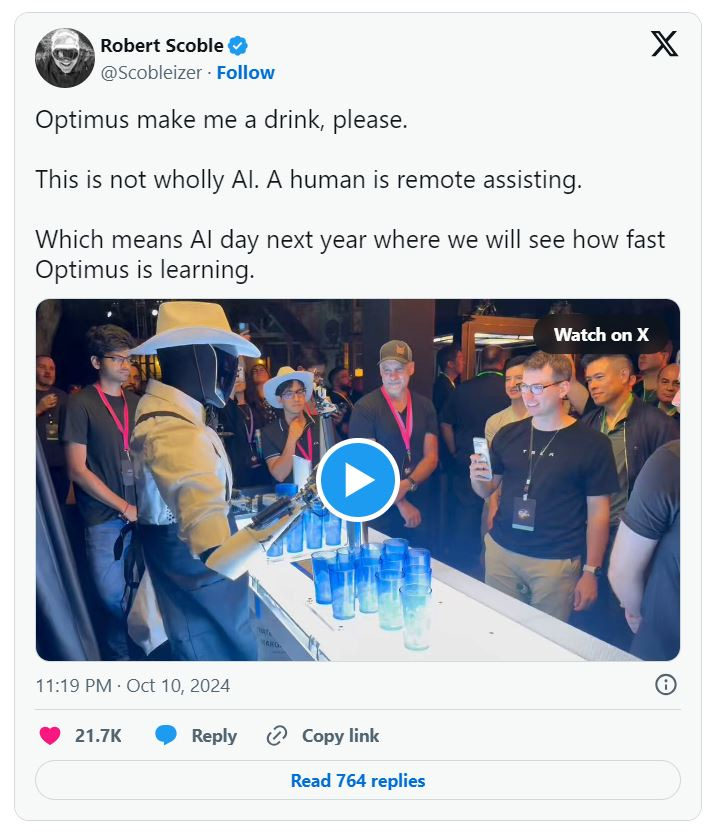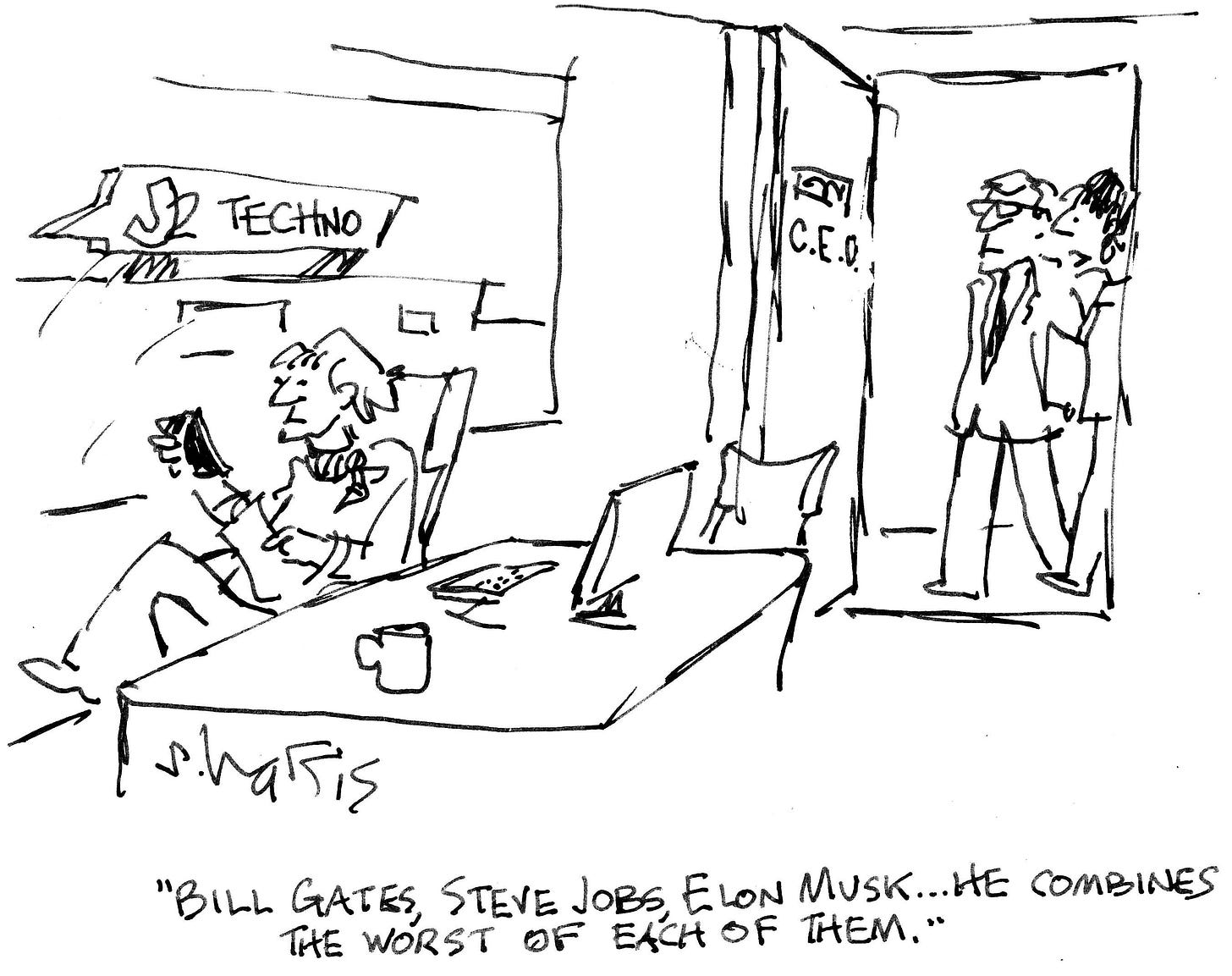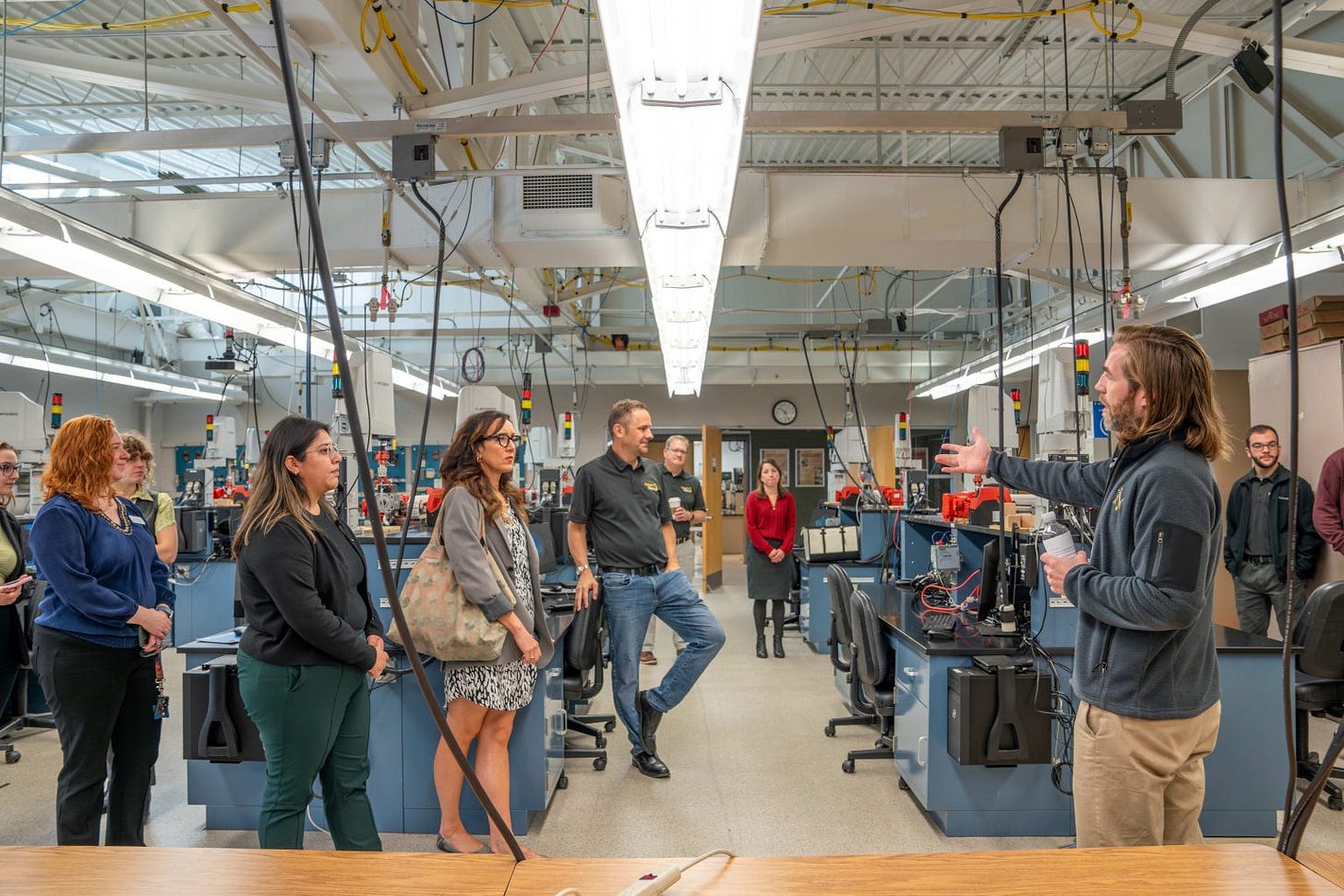Is "Fake It Until You Make It" No Longer Viable In Robotics?
Or are we just getting tired of Tech Bros?
Aaron’s Thoughts On The Week
"It’s not about what you sell; it’s about what people want to buy." – Seth Godin
This week, I travelled out to Silicon Valley for the annual RoboBusiness conference, which is put on by the fine folks at The Robot Report. This conference focused on the business and technology of robotics. The event brought together industry leaders, innovators, and entrepreneurs to discuss the latest trends, advancements, and opportunities in robotics. It features keynote speeches from the whose who of the robotics industry, panel discussions that dove deeper into specific topics, and networking opportunities galore, all aimed at helping businesses integrate and capitalize on robotics technologies.
It was very much a great look at the business side of the Robotics Industry and from the keynote by Robust.AI’s Rodney Brooks to the last demo by Torrey Smith, Co-founder & CEO of Endiatx, who swallowed a robot, the message was clear - We need to be making robots and robotic applications that people actually need and want.
In the rapidly evolving robotics industry, the days of "fake it until you make it" are quickly fading many of the speakers pointed out. As robots move from research labs to real-world applications, the pressure for market-ready solutions has never been higher. What was once tolerated as part of tech culture—where ambitious claims outpaced the actual development—now risks the credibility and long-term success of robotics companies. The industry is maturing, and with it, the demand for reliable, fully functional technology is paramount. In this new era, flashy pitches and overpromises must be replaced by tangible results, solid engineering, and practical innovation. As I left the show it was clear. The time for hype is over—now, it's all about delivery.
Tech Bros Are Getting Checked
"Tech Bro" culture—marked by overconfidence, aggressive ambition, and a "move fast and break things" mentality—is increasingly being shunned as the the tech industry, which includes robotics, matures and its impact on society becomes more scrutinized. The culture, often associated with excessive risk-taking, minimal accountability, and grandiose promises, has led to more and more high-profile failures which continues to erode public trust. Several factors contribute to this shift:
Overpromises and Under-delivery: The hype around emerging technologies, such as AI, autonomous vehicles, and blockchain, has frequently outpaced real progress. Companies that made bold claims without delivering viable products—like Theranos and its founder Elizabeth Holmes—have become cautionary tales. These examples show how "fake it until you make it" can lead to disastrous results.
Social Impact and Responsibility: As tech companies grow in influence, their societal impact is under increased scrutiny. From privacy violations at Facebook to content moderation issues at Twitter/X, the ethical concerns surrounding how tech products shape society have led to a growing distrust in tech leadership. The perception that "Tech Bros" prioritize profits over social responsibility has fueled public skepticism.
Toxic Work Culture: Reports of toxic workplace environments—such as those at Uber during its early days—have highlighted issues with sexism, aggressive competition, and poor management. This "bro" culture has led to broader conversations about diversity, inclusion, and the need for more ethical leadership.
Financial Mismanagement: Companies like WeWork, under former CEO Adam Neumann, exemplified how excessive spending, overvaluation, and lack of sustainable business models can collapse, leaving investors and employees disillusioned.
In response to these issues, those in tech are starting to gravitate toward a more transparent, accountable, and results-oriented approach. Investors, consumers, and regulators now expect real innovation and ethical behavior rather than hype-driven promises and unchecked ambition. The backlash against "Tech Bro" culture signals a demand for more mature leadership and sustainable business practices.
Tesla’s “We, Robot” Event May Have Broken The Dam
Tesla's "We, Robot" event, held on October 10, 2024, was supposed to showcase groundbreaking advancements in autonomous vehicle technology and robotics, but has since faced substantial criticism for not meeting expectations and being pretty much a Tech Bro Lovefest. I heard from many at RoboBusiness that the event may be the what has opened enough eyes that too much of the tech coming out now is just vaporware.
Overhyped Expectations and Underwhelming Delivery
In the lead-up to the event, Tesla CEO Elon Musk generated significant anticipation by promising revolutionary developments in autonomous vehicles and robotics. However, the event was marked by a lack of concrete details and timelines. For instance, while the newly unveiled Cybercab—a prototype robotaxi—was introduced with the claim of being priced under $30,000, specifics regarding its production timeline and regulatory approval were notably absent.
"Tesla yet again claimed it is a year or two away from actual automated driving - just as the company has been claiming for a decade. Indeed, Tesla's whole event had a 2014 vibe, except that in 2014 there were no automated vehicles actually deployed on public roads. Now there are real AVs carrying real people on real roads, but none of them are Teslas. Tonight did not change this reality; it only made the irony more glaring."
BRYANT WALKER SMITH, LAW PROFESSOR, UNIVERSITY OF SOUTH CAROLINA
Teleoperated Robots and Authenticity Concerns
A highlight of the event was the demonstration of Tesla's humanoid robot, Optimus. The robot was showcased performing tasks such as dancing and serving drinks. It was later revealed that these demonstrations were not entirely autonomous; instead, the robots were teleoperated by humans, raising questions about the genuineness of Tesla's robotic capabilities.
Impact on Tesla, Elon Musk, and Tech Culture
The event's shortcomings had immediate repercussions. Tesla's stock experienced a significant decline, dropping nearly 9% and resulting in a $67 billion reduction in market valuation. This downturn reflecting investor skepticism toward Tesla's ambitious claims and the broader "Tech Bro" culture that often emphasizes hype over substance.
The "We, Robot" event intended to position Tesla at the forefront of autonomous innovation but instead highlighted the pitfalls of overhype and under-preparedness, leading to diminished trust among investors and the public.
RoboBusiness Takeaway - Build S**t People Want
While robots like humanoids are great, they are simply not ready for grand deployments, especially into people’s homes. This is not to say that there should not be pilots and deployments into industrial settings like factories or warehouses, but we need to stop hyping that we are going to have armies of humanoids coming to market across all aspects of our lives.
At the recent Humanoid Robot Forum, there were many calls to temper the hype surrounding humanoid robots - this from fellow C-Suite members at humanoid companies. While these robots are making progress and showing promise, making bold claims like having millions of humanoid robots by 2030 or placing them in homes seems premature. We are still figuring out how to ensure safety around robots in industrial settings, and such lofty expectations could lead us to failure.
It should be noted that at both the Humanoid Robot Forum and at RoboBusiness there was very few actual humanoids present in their expo halls. This is just another sign of how much work is still needed, we still don’t even have enough functioning humanoids to have them at trade shows - because they are either still being worked on or involved in pilots to get better.
As stated earlier, Rodney Brooks really set the tone for RoboBusiness and why it is important to be transparent in what your robot can and cannot do. This leads to getting customers to trust you and what you are selling. Also, like Melonee Wise said at the Humanoid Robot Forum, Rodney stressed the need to be building solutions that actually solve the problems companies are facing with reliable applications. Rodney’s solution is our Video of the Week, so see more about it below.
So Are We Going To Change?
While I like to be optimistic about the robotics industry's future, I think Tech Bro culture and the “Fake It Till You Make It” attitude will more than likely continue for the foreseeable future. However, they have been called out, and I think we will continue to see them being called out.
Ultimately, when those who choose to proceed down that path only to fail, hopefully they learn and correct course and realize that actually delivering on their promises is when they get the win and the bigger prize of satisfied customers will all of this change. My hope is that more of them learn that before they do long term damage to our industry because as the old adage goes, “It only takes one bad apple to ruin them all.”
Let’s weed out the bad ones together.
Robot News Of The Week
Boston Dynamics and Toyota Research Team Up on Robots
Boston Dynamics and the Toyota Research Institute (TRI) have announced a partnership to accelerate the development of general-purpose humanoid robots. The collaboration will combine Boston Dynamics' advanced Atlas robot with TRI's AI-based large behavior models (LBMs). This partnership focuses on fundamental robotics research, addressing complex manipulation tasks and sharing the results with the community.
Boston Dynamics brings its highly capable humanoid platform, Atlas, known for advanced whole-body movements, while TRI contributes its expertise in AI learning techniques. Together, they aim to enhance Atlas' capabilities, allowing it to perform more sophisticated tasks through AI-driven learning.
The project will gather data from Atlas' physical performance to train LBMs, improving the robot's dexterity and whole-body skills. The joint team will also explore human-robot interaction, safety, and whole-body sensing, advancing the broader field of robotics.
Both organizations acknowledge the excitement around humanoid robots but emphasize the importance of transparent, science-driven progress over short-term hype. They aim to answer fundamental questions in robotics, leveraging their combined expertise to push the limits of what humanoid robots can do.
A&K Robotics refocuses micromobility testing in select airports
A&K Robotics, based in Vancouver, is addressing the growing demand for mobility assistance at airports through the development of self-driving robotic pods, like its Cruz model, designed to assist people with mobility limitations. The company has tested its systems at major airports like Vancouver International and Atlanta's Hartsfield-Jackson, with a focus on high operational standards and efficiency, rather than novelty.
The robots are connected IoT devices, enabling airports to track and manage fleets, improving efficiency by allowing remote deployment to gates. A&K is partnering with Bell Canada, Delta-Q Technologies, and the Rick Hansen Foundation to create a robotics ecosystem with cloud infrastructure and 5G connectivity for scalability.
With the global micromobility market expected to grow significantly, A&K Robotics is positioned to lead this expansion. The company is working with strategic accounts in Canada, the U.S., and Europe and aims to create sustainable mobility solutions for airports that can eventually extend to broader smart-city applications.
Formant, Slalom partner to help companies accelerate automation adoption
Formant, a cloud robotics management software provider, and Slalom, a global business and technology consulting firm, have formed a strategic partnership to simplify the adoption of automation and robotics for enterprise companies. They are showcased their combined technologies at RoboBusiness 2024 through live demos of robots streaming into the Formant platform, called the “Robot Corral.”
Many businesses face barriers to adopting robotics due to uncertainties and complexities. By merging Slalom's expertise in digital transformation with Formant’s robotics platform, the partnership aims to reduce risks and accelerate automation adoption. They plan to offer services covering the entire automation lifecycle, including readiness assessments, roadmap development, seamless integration, and continuous performance optimization.
The collaboration will help organizations develop pilot projects and fully operational systems, allowing businesses to quickly realize the benefits of automation. This comprehensive approach ensures that companies can navigate the complexities of automation with confidence and achieve strategic business goals.
Robot Research In The News
Humans sympathize with, and protect, AI bots from playtime exclusion, finds study
A study by Imperial College London found that humans often sympathize with AI bots and attempt to protect them from exclusion in social situations. In a virtual ball game called Cyberball, participants were more likely to include AI bots that were being unfairly left out, similar to how they would react to human exclusion. This tendency was stronger among older participants.
The study suggests that people tend to treat AI as social beings, raising important considerations for designing AI agents. While this could enhance collaboration, there are concerns about people forming social bonds with AI, especially in areas like health advice. Researchers advise against designing AI to be overly human-like to help users differentiate between virtual and real interactions.
The study also highlights that these virtual interactions may not fully reflect real-life communication, and further research will explore face-to-face interactions with AI to test these findings.
Combining next-token prediction and video diffusion in computer vision and robotics
MIT's CSAIL researchers have developed a new training technique called Diffusion Forcing to enhance sequence models, combining the strengths of next-token and full-sequence diffusion models. These models are widely used in AI, like ChatGPT for text and Sora for video generation. Diffusion Forcing enables robots and AI systems to predict and act on tasks more flexibly and accurately by managing noise in data and anticipating future actions.
The technique improved performance in various tasks, from robotic manipulation to video generation. For example, it helped a robotic arm complete complex tasks despite visual distractions and generated more stable, high-resolution videos compared to existing models. It also excelled in motion planning, solving a 2D maze faster than other methods.
This approach is expected to have broad applications in robotics and AI, allowing robots to perform tasks based on their surroundings without prior training. The team plans to scale up their method, aiming to develop a "world model" that simulates real-world dynamics, potentially enabling robots to learn by watching internet videos. Their research will be presented at NeurIPS in December.
Robot Workforce Story Of The Week
The Shapiro Administration has announced a $200,000 investment in Millersville University’s Robotic WorX program to support training in automation and robotics for high school and undergraduate students. This Manufacturing PA Training-to-Career (MTTC) grant will create paid internships, provide training, and fund necessary supplies, helping to eliminate financial barriers for students.
Gwen Ross, Director of Workforce Development Initiatives, highlighted the state's commitment to building a strong workforce and boosting Pennsylvania's manufacturing industry. The program, in partnership with Precision Cobotics, aims to impact over 2,000 individuals in the next two years through internships, mentoring, and STEM engagement events.
The grant will enable students to gain hands-on experience with robotics, preparing them for careers in manufacturing and addressing real-world industry challenges.
Robot Video Of The Week
Robust.AI has launched Carter™ Pro, a collaborative robot that merges AI with tactile interaction to boost workplace productivity. It utilizes advanced AI for environmental understanding and natural interactions, allowing workers to control its operation—either autonomously or collaboratively.
Carter Pro features data-driven adaptability, a 360° vision system, and a force-sensitive handlebar for precise navigation. With added tools like a put-to-light system and built-in barcode scanner, it enhances efficiency.
Designed to support rather than replace human workers, Carter Pro helps reduce cognitive load. Deployed with DHL Supply Chain in the US and Mexico, it enables scalable operations while ensuring control and safety. Key features include an AI-optimized vision system, vSLAM technology, and an intuitive touch screen for easy use.
Upcoming Robot Events
Oct. 21-23 ROSCon (Odense, Denmark)
Oct. 23-26 International Conference on Social Robotics (Odense, Denmark)
Oct. 28-Nov. 1 ASTM Intl. Conference on Advanced Manufacturing (Atlanta, GA)
Nov. 22-24 Humanoids 2024 (Nancy, France)
Jan. 7-10 CES (Las Vegas, NV)
Jan. 21-24 Intl. Symposium on System Integrations (Munich)
Mar. 4-6 Intl. Conference on Human-Robot Interaction (Melbourne)
Mar. 21-23 Intl. Conference on Robotics and Intelligent Technology (Macau)
May 12-15 Automate (Detroit, MI)
May 17-23 ICRA 2025 (Atlanta, GA)
May 18-21 Intl. Electric Machines and Drives Conference (Houston, TX)
May 20-21 Robotics & Automation Conference (Tel Aviv)
Aug. 18-22 Intl. Conference on Automation Science & Engineering (Anaheim, CA)
Oct. 19-24 IROS (Hangzhou, China)










Our focus should be on creating robots and robotic applications that are not just innovative, but also practical and in line with the needs and desires of people.
That is the right approach, but they're no publicly available scientific basis to support such a development.
I generally solved the problem of understanding and devised an approach that allows the development of artificial subjective systems. That approach allows the development of humanoids capable of doing all things affordable to us and stationary systems that can understand the meaning of information where mobility is not required and adapt to it.
Where are my partners?
You should include to the upcoming events list the IEEE RoboSoft conference!